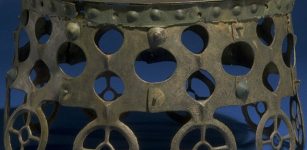Yam: Tyrannical Hydra-Like Sea Monster God Cast Out Of Heaven
A. Sutherland - AncientPages.com - Yam (Yamm), (in Hebrew, means ‘sea’) is best known from Canaanite tablets unearthed at Ugarit and related in myths to Baal, the son of the supreme god El, and the universal god of fertility who was titled ‘Prince, Lord of the Earth.’
Destruction of Leviathan, engraving by Gustave Doré, 1865. Credit: Public Domain
The tablets inform that at the beginning of time, Yam was awarded the divine kingship by El, the chief god of the pantheon - father of all the other gods “Creator/Possessor of Heaven and Earth” (except for Baal).
Yam, a tyrannical, monstrous deity of the sea and other watery realms, was in constant conflict with Baal. These two gods met each other in combat on the plains of heaven and, after his defeat, Yam was cast out of heaven and into the depths of chaos.
Despite what happened to him, he remained in conflict with Baal and wished to dethrone him to rule in heaven. So he came back from the depths beneath the seas to battle for heaven’s gates.
In some versions of the myth, Yam and Baal repeatedly kill each other, resurrect, fight again and die, only to return to life once more. This repeating mythological battle may symbolize furious winter sea storms, which usually calmed in the spring.
Goddess Astarte. Credit: A. Ocram - Public Domain
Some myths found in a fragmented ancient papyrus say that the goddess Astarte was deeply discontented by tributes Yam demanded from other gods. Yam threatened to flood the whole earth if he did not get what he wanted.
El instructed the craftsman-god, Kothar wa-Khasis, to build a palace on his (El’s) grounds and officially announced that his (eldest or favorite?) son is to be known as ‘El’s Beloved Yam’ and as Master, he probably authorizes Yam to banish Baal from his throne.
God El - King of the Gods. Gilded statuette of El from Megiddo. Credit: Daderot - Public Domain
But Yam still wanted more. He requested that the gods surrender Baal to be his bondservant. El finally agreed, but Baal refused and instead decided to meet Yam in a decisive battle.
After a furious fight, using two special weapons delivered to him by the craftsman Kothar, Baal managed to defeat Yam, scattering the pieces of his body. The battle was won, and now the kingship finally belonged to Baal.
In the Egyptian version of the story, the monster god Yam was defeated by Seth, with whom Baal was identified in the Ugaritic myth.
Yam is not clearly described in the available sources and has no clear appearance, though he seems to be serpentine in form.
Some believe that Yam may have had a great, seven-headed sea monster in his following, or he could also himself have been that monster.
According to some scholars, Yam is identical with the god Lotan (Hebrew: Leviathan) – a representation of a serpent or a many-headed dragon and is the model for Satan in the Biblical Book of Revelation (12:9).
Yam seems entirely motivated by rage, his actions are apparent, and he makes no secret of his disrespect for the other gods and their weak and clearly imperfect creations - humans.
Additionally, this figure is also associated with the Christian devil, with a serpent present in the Garden of Eden in the Book of Genesis, chapter 3.
Scholars know of no ancient Egyptian cult related to the monstrous Yam. However, it is known that Egyptian seafarers widely feared Yam. In addition, if we assume that Yam was also Satan, he must have been feared by many others as well.
Written by – A. Sutherland - AncientPages.com Senior Staff Writer
Updated on June 27, 2021
Copyright © AncientPages.com All rights reserved. This material may not be published, broadcast, rewritten or redistributed in whole or part without the express written permission of AncientPages.com
Expand for referencesSources:
Grottanelli, Kings and Prophets
J.B. Pritchard, Ugaritic Myths, Epic and Legends
More From Ancient Pages
-
 Little Known History Of Amazon’s Ashaninka People Studied By Researchers
Archaeology | Mar 21, 2023
Little Known History Of Amazon’s Ashaninka People Studied By Researchers
Archaeology | Mar 21, 2023 -
 Ensisheim Meteorite Is The Oldest Meteorite With A Precise Date Of Impact
Ancient History Facts | Jun 29, 2018
Ensisheim Meteorite Is The Oldest Meteorite With A Precise Date Of Impact
Ancient History Facts | Jun 29, 2018 -
 Tomb Of Christopher Columbus Finally Found But There Is One Problem With His Body
Archaeology | Apr 9, 2022
Tomb Of Christopher Columbus Finally Found But There Is One Problem With His Body
Archaeology | Apr 9, 2022 -
 On This Day In History: Knights Templars’ Jacques de Molay Burned At The Stake – On Mar 18, 1314
News | Mar 18, 2017
On This Day In History: Knights Templars’ Jacques de Molay Burned At The Stake – On Mar 18, 1314
News | Mar 18, 2017 -
 Rhetorica ad Herennium: Ancient Book That Improves Your Memory Using Method Of Loci – You Can Test It Easily
Featured Stories | Nov 13, 2023
Rhetorica ad Herennium: Ancient Book That Improves Your Memory Using Method Of Loci – You Can Test It Easily
Featured Stories | Nov 13, 2023 -
 DNA Sheds Light On The Iron Age Log Coffin Culture In Pang Mapha, Thailand
DNA | May 20, 2024
DNA Sheds Light On The Iron Age Log Coffin Culture In Pang Mapha, Thailand
DNA | May 20, 2024 -
 Mysterious Balkåkra Disc – Rare Strange Bronze Artifact Found In A Bog
Artifacts | Jul 25, 2019
Mysterious Balkåkra Disc – Rare Strange Bronze Artifact Found In A Bog
Artifacts | Jul 25, 2019 -
 Undeciphered Singapore Stone’s Carvings – New Attempt To Crack The Puzzle
Artifacts | Jun 11, 2024
Undeciphered Singapore Stone’s Carvings – New Attempt To Crack The Puzzle
Artifacts | Jun 11, 2024 -
 Thousand-Year-Old Farming Techniques And Irrigation Systems Can Be Used To Mitigate Climate Change
Archaeology | Mar 7, 2018
Thousand-Year-Old Farming Techniques And Irrigation Systems Can Be Used To Mitigate Climate Change
Archaeology | Mar 7, 2018 -
 The Assyrian Siege Ramp And Breached Walls At Canaanite City Of Lachish – Studied
Archaeology | Nov 10, 2021
The Assyrian Siege Ramp And Breached Walls At Canaanite City Of Lachish – Studied
Archaeology | Nov 10, 2021 -
 What Was The Extreme Ritual Of Sokushinbutsu?
Ancient Traditions And Customs | Jun 20, 2018
What Was The Extreme Ritual Of Sokushinbutsu?
Ancient Traditions And Customs | Jun 20, 2018 -
 Neanderthals Are Not The Only Species Whose Dentition Is Characterized By The Possession Of Thin Enamel
Archaeology | Jan 19, 2023
Neanderthals Are Not The Only Species Whose Dentition Is Characterized By The Possession Of Thin Enamel
Archaeology | Jan 19, 2023 -
 On This Day In History: Vlad II Known As Vlad Dracul (‘Vlad The Dragon’) Was Born – On August 30, 1400
News | Aug 30, 2016
On This Day In History: Vlad II Known As Vlad Dracul (‘Vlad The Dragon’) Was Born – On August 30, 1400
News | Aug 30, 2016 -
 11 Reconstructions Of Ancient Cities, Monuments And Sacred Sites
Civilizations | Jun 25, 2024
11 Reconstructions Of Ancient Cities, Monuments And Sacred Sites
Civilizations | Jun 25, 2024 -
 Intriguing 3,400-Year-Old Multipurpose Pyramid Found In Kazakhstan
Archaeology | Nov 2, 2023
Intriguing 3,400-Year-Old Multipurpose Pyramid Found In Kazakhstan
Archaeology | Nov 2, 2023 -
 Överhogdal Tapestry: Amazingly Well-Preserved Ancient Textiles With Norse And Christian Motifs
Artifacts | Apr 26, 2019
Överhogdal Tapestry: Amazingly Well-Preserved Ancient Textiles With Norse And Christian Motifs
Artifacts | Apr 26, 2019 -
 On This Day In History: Archbishop Thomas Becket Murdered – On Dec 29, 1170
News | Nov 29, 2016
On This Day In History: Archbishop Thomas Becket Murdered – On Dec 29, 1170
News | Nov 29, 2016 -
 Rare Bronze Oil Lamp With A Face Cut In Half Unearthed In Israel
Archaeology | May 7, 2021
Rare Bronze Oil Lamp With A Face Cut In Half Unearthed In Israel
Archaeology | May 7, 2021 -
 Remains Of Graeco-Roman Temple Discovered Near Egypt’s Siwa Oasis
Archaeology | Apr 6, 2018
Remains Of Graeco-Roman Temple Discovered Near Egypt’s Siwa Oasis
Archaeology | Apr 6, 2018 -
 Tower Of The Winds And Daydreaming Of Andronicus Of Cyrrhus
Featured Stories | May 14, 2019
Tower Of The Winds And Daydreaming Of Andronicus Of Cyrrhus
Featured Stories | May 14, 2019



